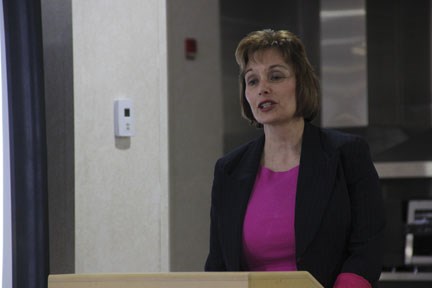The issues of power generation and greater consumption were the topics of the day at the Estevan Chamber of Commerce's luncheon last week, along with the future of coal in Estevan through the carbon capture project.
SaskPower's Judy May, vice-president of special operations, was the speaker at the luncheon April 9 at the Boundary Lodge camp northeast of the city, and she stressed the growing need for new infrastructure in Saskatchewan that will be needed to meet the energy demands across the province in the coming years.
She said the power needs in the province will increase by 30 per cent in the next 20 years, while the demand will double by 2050. The province will need to generate 1,300 more megawatts of power through new infrastructure by 2033, and May said they are looking at a number of sources to fill that need, including gas and wind generation.
Looking at coal's future in helping meet those needs, the results of the carbon capture project at Boundary Dam Unit 3 will be a big determinate. May broke down the province's current energy production as 37 per cent coming from coal with the same amount from gas, 20 per cent from hydro, five from wind and the final one per cent coming from a menagerie of sources such as geothermal and solar.
May noted that Saskatchewan will decrease the percentage of power generation produced by coal heading into the future with environmental concerns, federal regulation and the rise of alternative energy sources. In order to continue using the fossil fuel as a primary source, SaskPower is putting a lot of faith in the carbon capture project.
The project, which is hoped to cut emissions by 90 per cent, was slated for completion on April 1, but announcements earlier this year said that deadline would be missed. May said commissioning work is ongoing at the project site and the project would be complete and online by the end of the year, without giving any specifics on an estimated completion date.
"Our best comment on that is that we fully anticipate it will be up and running by the end of the year. We're into commissioning now and we'll be continuing to add to those commissioning activities," said May. "There's a lot of work to be done on what we call both the capture island side and the power island side and, of course, integrating those two major components together to make the capture unit work properly."
May said they do not have estimates on how much the further delays will add to the total cost of the project, which has already gone $115 million over the original $1.24 billion budget.
"We certainly will continue to be working on those numbers as we go forward in the next while as we continue to work on commissioning. Commissioning is our focus right now, and we'll continue to keep control and track of what we're doing on the expenditure side, but we won't be in a position to comment on that for awhile."
Though coal will be looked on to produce a smaller percentage of the province's power, Estevan is likely to continue as the Energy City for years to come.
"We've certainly invested a lot of time and effort and money in the carbon capture facility that we're bringing online and we want to be able to bring that unit up and running, stabilize it and have it running in a steady state and be able to do an analysis about the art of the possibilities going forward in terms of coal," said May.
SaskPower is committing $1 billion each year to infrastructure requirements of the future, which May noted is about 40 per cent of everyone's power bill.
The utility also set a record for peak production in 2013 during the winter, producing 3,543 megawatts. That was an increase of 100 megawatts from the day before, which was a record-setter itself. May also noted that while the winter is when the demands are typically highest, the demand throughout the summer is closing the gap between the two seasons' power needs.
"We're now in a situation where the summer peak is close to the winter peak, which is quite a phenomenon for our situation," she told the chamber members.
She also said SaskPower will have to deal with the labour requirements in the near future, as 50 per cent of their employees are eligible for retirement in the next decade.




